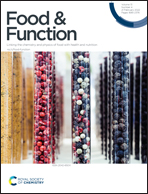The relationship between the structure and functionality of essential PUFA delivery systems based on sodium caseinate with phosphatidylcholine liposomes without and with a plant antioxidant: an in vitro and in vivo study†
Abstract
The aim of this work was to establish the main relationship between the structure and functionality of supramolecular complexes formed by sodium caseinate (SC) with phosphatidylcholine (PC) liposomes filled with fish oil (FO) to an equal mass ratio of n-3 to n-6 polyunsaturated fatty acids (PUFA) in the absence and presence of one of the most effective plant antioxidants, namely the essential oil of clove buds (EOC). The functionality of the supramolecular complexes (SC–PC–FO and SC–PC–FO–EOC) was considered from the point of view of the possibility of their use as effective delivery systems for long-chain n-3 PUFAs (eicosapentaenoic (EPA) and docosahexaenoic (DHA) acids from FO). The laser light scattering method was used in the static, dynamic and electrophoretic modes to characterize the structure and thermodynamic parameters of the supramolecular complexes in an aqueous medium. It was found that the SC–PC–FO and SC–PC–FO–EOC complex particles had the following similar properties: nanosize; a spherical shape; 100% solubility in an aqueous medium (pH 7.0, ionic strength = 0.001 M); a high encapsulating ability of SC (up to 70%) in relation to the studied liposomes; and a high protective ability relative to lipid autooxidation (up to 96% on the 20th day of storage at room temperature in light). In addition, a sequential transformation of both the structural and thermodynamic parameters has been observed for the complex particles under in vitro simulated gastrointestinal (GI) conditions in accordance with the INFOGEST protocol. A greater release of the encapsulated lipids from the enzymatically hydrolyzed complex particles was observed at the small intestine stage compared to their release at the gastric stage. These data were in good agreement with those on the assessment of the bioavailability of the target PUFAs in in vivo experiments based on the chronic intake of aqueous solutions of the complexes (both SC–PC–FO and SC–PC–FO–EOC) by experimental mice for 92 days. Liver lipid profiles of the mice, obtained by gas–liquid chromatography, showed the following: (i) an almost twofold increase in the DHA content as compared with that of the control; (ii) an almost threefold decrease in the mass ratio of arachidonic acid (AA) (C20:4 n-6) to DHA (C22:6 n-3) compared to that of the control due to both a significant decrease in the AA content and a simultaneous pronounced increase in the DHA content; and (iii) an almost twofold decrease in the mass ratio of the total amounts of n-6 to n-3 PUFAs compared to that of the control.



 Please wait while we load your content...
Please wait while we load your content...